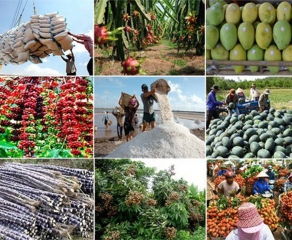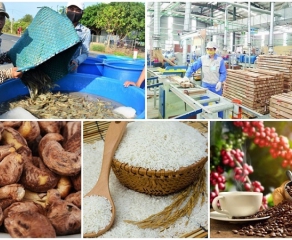WHAT IS AN INTERNATIONAL PORT? IMPORTANCE OF INTERNATIONAL SEAPORTS TO ECONOMIC DEVELOPMENT?
After joining the World Trade Organization, Vietnam has gradually transformed to bring the developed national economy to the world. One of the strengths of Vietnam's economy is the marine economy with a port system stretching along the length of the country. The sea is really attached to and greatly affects the socio-economic development of the country. So do you really understand what an International Port is? What is the significance of the international port in the socio-economic development of the country?
After joining the World Trade Organization, Vietnam has gradually transformed to bring the developed national economy to the world. One of the strengths of Vietnam's economy is the marine economy with a port system stretching along the length of the country. The sea is really attached to and greatly affects the socio-economic development of the country. So do you really understand what an International Port is? What is the significance of the international port in the socio-economic development of the country?
1. What is the international port?
Seaport is a port located on the coast with facilities for loading and unloading goods or a place to pick up or take passengers by waterway. A seaport is an area including port land and port water area, where infrastructure is built and equipment is installed for ships entering and leaving to operate to load and unload goods, pick up and drop off passengers and carry out other activities. other services.
A seaport consists of berths in a water area of a certain depth and width for ships to anchor or dock. Seaports are usually deep-water ports serving large ships with high tonnage. According to the goods served, cargo ports can be divided into many types of specialized ports such as bulk ports, container ports, and fuel ports.
Services and procedures at the port include: loading and unloading services, wharf and warehouse services for goods storage, transportation services in and out of the port, customs clearance.
An international seaport is a seaport serving domestic and international water transport needs. Major international seaports of Vietnam such as Hai Phong port, Vung Tau port, Van Phong port, Quy Nhon port, Saigon port...
2. What is the international port in English?
International port in English is understood as International port.
Port land is the limited land for the construction of wharves, warehouses, factories, headquarters, service facilities, transportation systems, telecommunications, electricity, water, other ancillary works and equipment installation.
Port water area is a limited water area for setting up the water area in front of the wharf, the turning area for ships, the anchorage area, the transshipment area, the storm shelter area, the pilot receiving and disembarking area, the quarantine area; area to build seaport channels and other ancillary works.
3. Importance of international ports to economic development
Seaports play a very important role - the driving force for the development of the marine economy in particular and the country's economy in general. This is the gateway to trade in import and export goods, the focal point for converting sea transport to rail, road and inland waterway transport. As a coastal country, our country has nearly half of the provinces and cities with the sea, with a total coastline of over 3,260 km running along the length of the country; It has a large sea area with many peninsulas, lagoons, deep bays, airtight, projecting the international maritime route between the Indian Ocean and the Pacific Ocean. From Vietnam's coastal ports in the East Sea through the Malacca Strait to the Indian Ocean, the Middle East, Europe, Africa, etc., through the Bashi Strait into the Pacific Ocean to the ports of Japan, Russia, and Europe. America.
*) For import-export activities and international economic integration.
The history of the world's shipping industry shows that the marine economy has always been considered a spearhead industry, in which the main role is the seaport. Where there is a seaport, there will be a city with developed economy, industry and trade. Prosperous seaports, stronger marine economy. In the development strategies of many countries in the world, it has been determined that the 21st century is the century of the ocean, strongly directing the development to the sea and islands, paying special attention to the exploitation of the sea (including the developing countries). no sea). Marine researchers have also confirmed that the port economy plays a key role. In the socio-economic development strategy of our country in the coming time, industrial development is determined to play a key role, in which the development of export processing zones and concentrated industrial parks play a key role. In which, the development of export processing zones and concentrated industrial zones plays a very important role. Industrial zones first and foremost affect industrial production for export and domestic consumption, increasing economic growth rapidly and steadily GDP, on the other hand better protect the ecological environment. This is a long-term and fundamental benefit for a developing country like ours.
As we all know, seaports are a special material production industry, serving to facilitate economic development. Seaports are a driving force, creating a market, an economic connector between countries, stimulating market development, actively attracting investors, merchants and manufacturers to operate. business.
On the world scale, the trend of globalization and regional integration is becoming a trend of the times. Any economy, if it does not operate according to this trend, will inevitably be eliminated from development sooner or later. Among the transportation and exchange of goods by road, air and sea, it can be said that seaway meets the most transportation needs because it contributes to the development of transport connecting with the most countries and has the lowest cost but can meet the largest volume of transport. Therefore, for many years, countries in the world that have the ability to develop sea routes have focused on developing strongly the maritime system.
*) For economic restructuring.
Economic structure is a criterion reflecting qualitative changes, a sign of evaluation and comparison of economic development stages. The economic structure manifests itself in many different forms such as: the structure of the economic sector, the structure of the economic region, the structure of the economic components, the structure of the institutional sector, etc. In which, the structure of the economic sector is the most important because it reflects the development of the social division of labor and the development of the productive forces. The trend of industry restructuring is an important content of the country's industrialization and modernization process.
The structure of the economic sector is the correlation between the sectors in the overall economy, showing the organic relationship and the reciprocal interaction in both quantity and quality between industries.
Economic sector restructuring is the process of changing the industry structure from one state to another to become more and more complete, more suitable to the environment and development conditions.
The development of the port system will promote exports, develop foreign trade and other port logistics services. One of the basic conditions for a port or a port to operate is that it must be near a source of goods or near the areas that attract goods from which the seaport can promote its role as a hub for goods consumption. chemical. On the other hand, the development of seaports is a condition that promotes the formation of industrial parks, export processing zones and, along with it, centers of trade, finance, maritime services, etc., which are formed and developed around the system. port.
Being well aware of the importance of the sea and islands and developing the marine economy, over the years, the Party and State have issued many resolutions, directives, strategies for planning, construction and development of seaports, such as: Decision No. 202/1999/QD-TTg, dated October 12, 1999 of the Prime Minister on the master plan on development of Vietnam's seaports up to 2010, Decision No. 1037/QD-TTg, dated June 24, 2014 of the Prime Minister on Approval to adjust the master plan on development of Vietnam's seaport system to 2020, with orientation to 2030, etc., and synchronously deploy solutions to build and develop the seaport system in the context international integration. Thanks to that, at present, our country's seaport system is planned, invested and developed quite comprehensively in terms of scale, quantity, wharf length, capacity, tonnage and modernity, meeting the needs of customers. import, export, sea freight both domestically and internationally.
However, the planning, development and exploitation of seaport services are not commensurate with the available potentials and advantages; the seaport system is still scattered and fragmented; transport infrastructure, industrial parks have not developed synchronously with the seaport system; outdated technology, means and machinery; customs service quality is still limited, customs clearance costs are high; investment is scattered, the structure is not reasonable, there is an excess of small ports, a shortage of large and deep water ports; modernization is slow, not yet qualified to receive the world's medium and large tonnage ships, etc.
In order to overcome the above limitations, and at the same time continue to improve the comprehensive capacity of the seaport system, meet the requirements of industrialization and modernization of the country and international integration, Resolution of the 8th Conference , The Party Central Committee (Term XII) on "Strategy for sustainable development of Vietnam's marine economy to 2030, with a vision to 2045" has set out the goal of maritime economic development: "The focus is on maritime economic development: operating seaports and shipping services. To plan, build and organize the synchronous and effective exploitation of general seaports, international transshipment ports and specialized ports associated with supporting services; building and completing logistics infrastructure system and traffic routes, connecting seaports with domestic and international regions, regions and localities. Promote the development of the shipping fleet with a reasonable structure, apply modern technology, improve service quality, meet the demand for domestic transportation, deeply participate in the transport supply chain, each increasing share of the international market”.
Accordingly, the Ministry of Transport shall closely coordinate with relevant ministries and branches, especially the Customs force, Party committees and authorities of coastal localities to concretize them into resolutions, plans, programs, projects and synchronously deploying solutions suitable to the characteristics, goals and requirements of local economic development, in order to improve the comprehensive capacity of the seaport system, contributing to the development of the marine economy in particular. the country's economy in general, successfully realizing the goal of turning our country into a country "strong in the sea, rich from the sea, sustainable development, prosperity, security and safety".
Conclusion: The developed seaport has promoted the trade of countries, becoming more and more effective. Seaport development promotes the import and export of goods and is a driving force for industrial development. Seaports are constructions that are not directly involved in a specific business activity, but only have a supporting role for production and business activities to take place smoothly, thereby promoting economic growth and development. economic restructuring.





